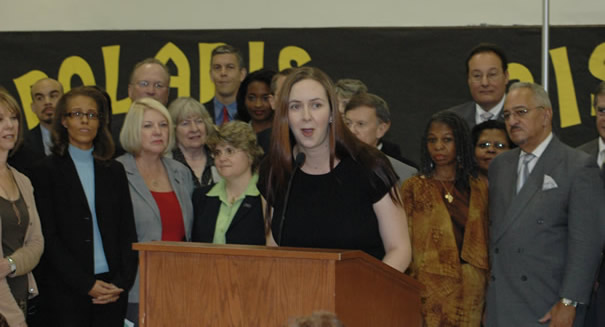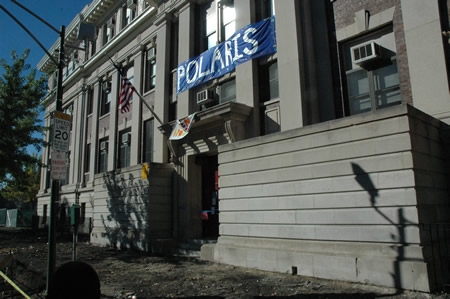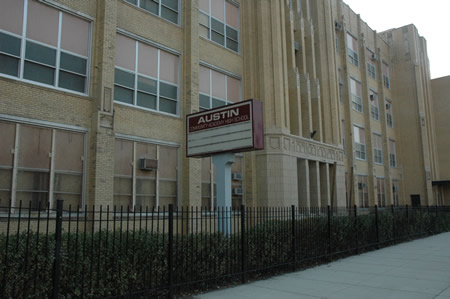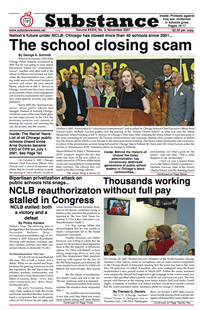The school closing scam

When Arne Duncan, CEO of the Chicago Public Schools, announced in 2005 that he was going to close Morse Elementary School for “underperformance”, teachers and other staff at the school mobilized and pointed out how unfair the characterization was. Laboring under some of the worst burdens of poverty and crime, the area around Morse, which sits at 620 N. Sawyer in Chicago, would once have been viewed as an example of how racial segregation and economic exploitation and oppression create ghettos, poverty, and other problems.
But by 2005, the “dominant narrative” about public schools had changed. Instead of blaming Chicago, which has some of the most brutal ghettos and tragic poverty in the USA, or the race and class inequities in the USA itself, the dominant narrative now consists of blaming the victims and excusing the city, the system, and the country. Although all the legitimate research showed that lower test scores are primarily the result of poverty and its related problems for children, Chicago persisted in leading the United States in blaming teachers, children and schools for the system itself.
So, on October 9, 2007, Chicago Schools Chief Executive Officer Arne Duncan told a crowd of reporters and others that he would continue to push the opening of “new schools” as part of Mayor Richard M. Daley’s “Renaissance 2010" program. "Renaissance 2010" was driving full speed ahead, with the total support of Chicago's corporate elite and corporate media, despite the fact that more and more of the new schools already opened by CPS have either failed or were only succeeding by manipulating their numbers. Additionally, in most cases, the "new schools" (like "Polaris" charter) were being built on the grave of public schools that had been ruthlessly destroyed by Daley and Duncan. The "new" schools also cost much more than average public schools.
“The whole thing is driven by privatization, not what’s good for the public,” said one critic. “This is what happens in any dictatorship.”
“And we owe a special thank you to the Walton Family Foundation,” Michelle Navarre, chief of the Polaris Charter School, told the cheering crowd of charter school operators, entrepreneurs, and political supports. Everyone cheered at the mention of the billionaires who gave the world Wal-Mart.
In a way, the Polaris administration was typical of the grandiosity of Chicago's charter schools, and of the governing jug
The expensive bureaucracy inside Polaris was a reflection of the equally expensive bureaucracy at Chicago's schools headquarters that was creating "Renaissance 2010." Many of the people in the central bureaucracy were hovering, often behind the scenes, at the Polaris opening.
One of the most important Chicago Public Schools officials present at the “Polaris” ceremony was a young man who had little inner city teaching experience, no Chicago teaching experience, and no teaching or administrative credentials in Illinois. But for those who appreciated ironies, the presence of Josh Edelman, Chicago’s fourth “Chief Officer” of “New Schools” in four years, was filled with it. Edelman’s mother, Marion Wright Edelman, had given “No Child Left Behind” its name. Like many who had once fought for civil rights and against segregation, Edelman was giving her name to the evils against which her colleagues and mentors had fought back when she worked with Martin Luther King Jr. in the 1960s.
What had happened in the inner cities of the USA was a complete transformation of the story line that is fed daily to Americans by their mass media, a story line not just produced by the right wing media, but also packaged and sold by the mainstream.
During the preceding five years, Chicago had become the leader in closing community based public schools. Most of the closings were a prelude to the worst excesses that will soon befall the rest of the USA under “No Child Left Behind.” They have long been the subject of Substance stories, but with this issue we are beginning a series of articles on how — and by whom — the closing of dozens of public schools and the destruction of black communities in what was once dubbed the “Black Metropolis” was accomplished.
Although the federal government was under the control of neo-conservatives and George W. Bush during the years Chicago attacked its public schools, in Chicago the job was being done by "liberals," all Democrats. The groundwork had been laid under corporate models of "school reform" that were put into place and cheered by the administration of President Bill Clinton, despite attempts by some to blame the Bush administration and No Child Left Behind for all of the tragedies that had been launched against the poorest children in the nation's big cities.

Michelle Navarre, "Director of Academics" at Polaris, was the main speaker at the October 9 event.
The most important speaker present was Chicago Schools Chief Executive Officer (CEO) Arne Duncan. When he was appointed to head the nation’s third largest school system in 2001, Duncan had even less teaching experience than Josh Edelman. But within a year after he began his career as a newly minted CEO, Duncan revealed what would become the main work of his administration: the closing of inner city public schools, the displacement of their faculties, and the privatization (usually, but not always, through charterization) of as many Chicago public schools as possible.
Duncan’s first attack on the integrity of the teachers and principals at Chicago’s inner city, usually all-black, public schools came less than a year after his appointment by Chicago Mayor Richard M. Daley. In April 2002, Duncan proposed that the Chicago Board of Education close three all-black inner city schools (all of which were staffed with mostly black teachers) and convert them into other entities.
Duncan’s proposal to close Dodge, Terrell, and Williams elementary schools prompted a firestorm of protest. Organized mainly by the Chicago Teachers Union, but supported also by leaders of other unions including the Service Employees International Union (SEIU) Local 73, a thousand people showed up at the April 2002 meeting of the Chicago Board of Education to protest the attacks on Dodge, Terrell and Williams.
Speaker after speaker at the April 2002 school board meeting pointed out that each of the schools had faced specific challenges that led to a drop in standardized test scores.
Dodge Elementary School had seen some of the worst “mobility” in Chicago as a result of the gentrification of the West Side in the area west of the United Center.
Terrell Elementary School had seen both mobility and a decline in membership as the result of the destruction of the public housing projects it used to serve in the "State Street Corridor." By 2002, Terrell had fewer than 200 students, in a school that once served more than 1,000.
Williams Elementary School had seen the children’s test scores decline — for one year only — because there was a gang war going on in the housing project (Dearborn Homes) that began less than 100 feet from the front entrance of the school.
The Dearborn Homes gang war of 2000 and 2001 that had caused the test scores to drop in May 2001 testing was the direct result of the closing of the housing projects adjacent to Terrell Elementary School. A gang named the "Mickey Cobras" (MCs) had controlled four housing project buildings at 54th and State St. When those four buildings were demolished, some of the MCs had moved north three miles into the Dearborn Homes housing project, adjacent to Williams Elementary School. There they ran straight into the Gangster Disciples (GDs) street gang, which had controlled parts of Dearborn Homes for more than a generation. The children attending Williams in 2001 — all of whom lived in Dearborn Homes — had been asked to concentrate on the Iowa Tests of Basic Skills while bullets were interrupting their lives both in school and at home after school each evening.
The facts didn’t matter. Arne Duncan was mandated to close black schools, and between April 2002 and the end of 2006, he had closed more than 30 of them. The official corporate narrative was that Duncan had shown rare "courage" by closing what the editors at both the Chicago Sun-Times and Chicago Tribune called "failing schools." All of the facts and history — what reporters used to call "source and context" — were conveniently ignored as the destruction of dozens of schools in Chicago's African American community began in April 2002 at Dodge, Terrell and Williams.
The official narrative had been scripted before the closings began. It has continued uninterrupted in the pages of Chicago's corporate media since, with the basic scripts being published in print, then repeated in television and radio.
In April 2002, No Child Left Behind was barely four months old. Chicago was already pioneering what would become a national trend if No Child Left Behind continued as planned until 2014.
The story of school closings in Chicago, a prelude to NCLB’s next phase, begins this month here.



